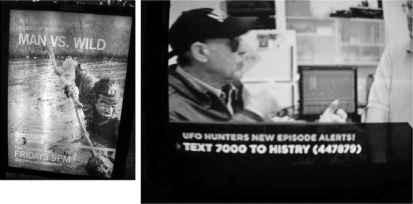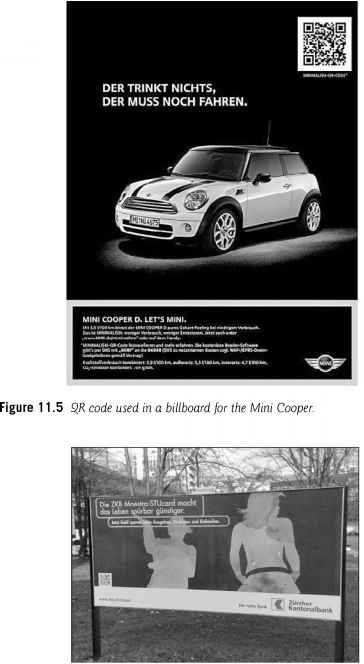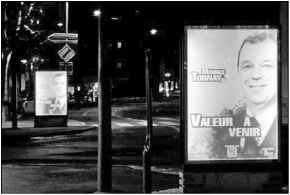Integrating with Broadcast Media
Whenever you are using a broadcast medium, you have the opportunity to loop a mobile marketing call to action into the campaign. Encourage people to communicate with a short code, through SMS; download an application; or simply visit your mobile site. The most common broadcast media include the following:
Streaming TV Radio
Movies
Television and cinema trailers
With the advent of Digital Video Recorders (DVRs), many people are fast-forwarding though commercials, so it is important to find other ways to reach them when they are watching TV. When you loop TV into your participatory marketing campaign, you can make up for the ever-diminishing viewership of TV commercial advertising.
Integrating Twitter feeds during news programs and talk shows is a simple way to loop in mobile communication. The History Channel was one of the first U.S. stations to do a good job of integrating mobile calls to action during programming. During many of their TV shows, a small banner appears on the screen, encouraging viewers to text in a short code to get an alert whenever a new episode of the current show is about to air (see Figure 11.4). You can also promote TV shows with offline Bluetooth display advertising, as they did for Man vs. Wild, to help improve viewership.

- Figure 11.4 The History Channel provides short codes that viewers can text so that they receive notices when new episodes of a favored show will air. Photos courtesy of mobile.kaywa.com.
American Idol was the first U.S. TV show to launch a mainstream text-messaging campaign, in which they allowed viewers to call or text in their votes to help determine which contestants would move on to the next round. Similarly, the show Deal or No Deal created a game that ran before every commercial, in which viewers could guess which one of six suitcases was holding $1,000,000; if they guessed correctly, they were entered into a contest to win the money.
Radio
If you are marketing for a radio station, you can encourage listeners to text in questions and comments about the show or have listeners text in song requests. You can also allow them to sign up to receive text alerts to find out when their favorite show or song is about to play, or send them information about concerts or events that the radio station will be sponsoring. You can also send listeners a link to your show where they can get a downloadable mobile music-streaming application to play your show. You could also provide links to where listeners can download the songs played on your show. Alternately, you can work with show sponsors to include a mobile couponing element with their advertising package, and send listeners mobile coupons, discounts, or promotions from show sponsors during the spot. In the United States, National Public Radio (NPR) does a great job integrating this kind of marketing into their programming.
If you are a mobile marketer who is interested in leveraging existing radio advertising campaigns, you can integrate a mobile call to action into your commercials. Encourage people to text in to get a discount, or have them send a mobile picture of them enjoying your product, to enter a contest. You can also use a radio commercial to promote any highly visible location-based marketing and explain how users can interact with it when they are nearby. Marketers can advertise existing mobile applications that your company has created to help improve the number of downloads and spread brand awareness.
Location-Based Broadcasts
Location-based broadcasts include digital signage, Bluetooth, WiFi, near field, and Infrared broadcasts. These technologies can be used to send marketing messages to users based on their physical location. Bluetooth beacons and WiFi routers can be used to broadcast marketing messages to people when they enter the range of the beacon. These are usually used to drive foot traffic into a brick-and-mortar store. Frequently, the message includes a coupon or promotion to incentivize a specific call to action. Mobile service providers can also leverage location information from GPS and cell tower triangulation to send targeted, location-specific messages alerts to subscribers, based on their location. In some countries, this type of communication is also being used to send regional safety and weather alerts. Chapter 6, "Mobile Promotion and Location-Based Marketing," covers location-based marketing more thoroughly.
Companies such as McDonald's are also testing location-based mobile marketing at the point of purchase by creating what they call the SMS Lounge. This German test presented a call to action at the point of purchase for the visitor to sign up and receive an instant coupon. Subsequently, visitors were offered the opportunity to opt in to future coupons sent via text message. Since its launch in July 2007, more than 10,000 participants have used this McDonald's service, and the brand has achieved response rates of up to 29%.
Integrating mobile marketing with location-based marketing is especially powerful because it can reach people both when they are short on time and need answers quickly, and when they have time to fill and need quick entertainment. You can use location-based marketing to interact with your demographic in a number of ways. The simplest method is to integrate a mobile call to action in billboards, banners, posters, and other outdoor advertising channels. You can take this integration to the next level by offering interactive SMS prompts, or even including QR codes or Bluetooth beacons on your advertisement. By promoting a specific mobile offering that is relevant to people in a particular location, you engage your audience and give them information that is uniquely valuable to them at that moment in time.
Figures 11.5 through 11.7 are good examples of how QR codes can be integrated into billboards and outdoor advertising. Figure 11.5 shows an ad for a Mini Cooper, Figure 11.6 shows a large billboard for a Swiss bank Zurcher Kantonalbank and finally Figure 11.7 features an image of Father Maurice Tournay, a Swiss missionary. In each of these ads, QR codes are included so that passersby can use their mobile phones to get more information on the topic. Information passed by QR codes from stationary advertising can be uniform, or can be tailored to the specific location of the advertisement. For instance, the Mini Cooper ad could give the viewer more information about the Mini Cooper, or it could give them directions from the billboard to the nearest dealership.
Similar to QR codes, image-recognition software, such as one created by Mobot, can be used to prompt mobile downloads. In this scenario, a company submits its print and display advertising to be scanned by a back-end database. That image is stored, and whenever someone takes a picture of the billboard and sends it in, the image-recognition software queries the database, to determine what advertisement it is; the database then sends a response to the phone, much like a QR code would.
The mobile marketing channel needs support from other media to be successful, so it is crucial to integrate it with your on- and offline marketing efforts. Appropriate integration will ensure that you are reaching your target audience effectively and efficiently, when they are most likely to interact with your marketing message.

- Figure 11.6 QR code integration in a billboard for Zürcher Kantonalbank.

- Figure 11.7 QR code integration in a lighted bus stop billboard for Maurice Tornay.
Continue reading here: Online Images Videos and Podcasts
Was this article helpful?